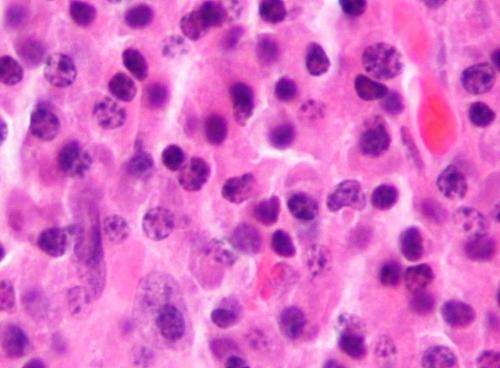This article has been reviewed according to Science X's editorial process and policies. Editors have highlighted the following attributes while ensuring the content's credibility:
fact-checked
peer-reviewed publication
trusted source
proofread
New therapy target to shut down multiple myeloma's ability to survive and thrive

Multiple myeloma (MM) is one of the most formidable and deadly cancers known to man, with only 50% of patients surviving for more than five years after diagnosis.
Characterized by the uncontrolled growth of plasma cells within the bone marrow, MM predominantly affects both men and women over 60.
Despite a host of available treatment options and combinations, MM continues to pose significant challenges for patients and clinicians, due to its prolific ability to adapt and grow, causing continual relapse with shorter remission windows each time.
Fortunately, new research from the University of Adelaide and SAHMRI, led by Dr. Bill Panagopoulos, is creating some hope, uncovering a promising new treatment that inhibits tumor growth and could have the potential to delay or even prevent relapse.
"Most people diagnosed with multiple myeloma in Australia are treated with a combination of chemotherapy and immunotherapy, which can initially help control the cancer. However, often patients experience treatment resistance and therefore relapse and ultimately die from this disease," Dr. Panagopoulos said.
"We believe this is partly because myeloma cancer cells are protected in the bone marrow by specialized cells that create a supportive environment for the cancer to survive and grow."
"Targeting the supportive environment together with standard-of-care anti-myeloma drugs, will ultimately improve patient outcomes."
The research team has identified a crucial player in this puzzle, myeloperoxidase (MPO), an enzyme associated with inflammation. MPO not only suppresses the activity of cancer-fighting immune cells but also fuels the growth of multiple myeloma in the tumor microenvironment.
Dr. Panagopoulos says blocking MPO activity inhibits myeloma progression in pre-clinical models and he's optimistic the development of novel drugs targeting MPO can be used in combination with standard anti-myeloma therapies to offer a significantly more durable treatment response.
The research team has partnered with a major pharmaceutical company to investigate the potential of re-purposing a potent MPO inhibitor, that's already passed Phase I/II clinical trials, for the treatment of MM.
"We're excited that this inhibitor has already been proven safe for human use. The translation of these results from the laboratory to the clinic promises to be rapid, offering hope for thousands of patients to prevent MM progression."
The team hopes to identify the critical data needed to develop a clinical trial and prove whether this new therapeutic approach is as effective at stopping MM progression in humans.
The findings are published in the British Journal of Haematology.
More information: Connor M. D. Williams et al, Myeloperoxidase creates a permissive microenvironmental niche for the progression of multiple myeloma, British Journal of Haematology (2023). DOI: 10.1111/bjh.19102

















